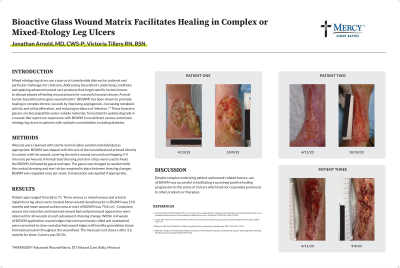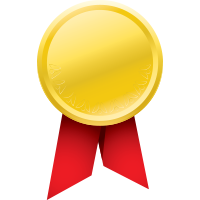Case Series/Study
(CS-010 (GR-001)) Bioactive Glass Wound Matrix Facilitates Healing in Complex Venous or Mixed-Etiology Leg Ulcers of Diabetic Patients

Mixed etiology leg ulcers are a source of considerable distress for patients and particular challenges for clinicians. Addressing the patient’s underlying conditions and applying advanced wound care products that target specific factors known to disrupt phases of healing are paramount for successful wound closure. A novel borate-based bioactive glass wound matrix* (BGWM) has been shown to promote healing in complex chronic wounds by improving angiogenesis, increasing metabolic activity and cell proliferation, and reducing incidence of infection. These bioactive glasses are biocompatible water-soluble materials, formulated to quickly degrade in a wound. We report our experience with BGWM in recalcitrant venous and mixed-etiology leg ulcers in patients with multiple comorbidities, including diabetes.
Methods:
Wounds were cleansed with sterile normal saline solution and debrided as appropriate. BGWM was shaped to fit the size of the wound bed and pressed directly in contact with the wound, covering the entire wound area and overlapping 3-4 mm onto periwound. A fenestrated dressing and steri-strips were used to fixate the BGWM, followed by gauze and tape. The gauze was changed as needed while the contact dressing and steri-strips remained in place between dressing changes. BGWM was reapplied once per week. Compression was applied if appropriate.
Results:
Patient ages ranged from 68 to 71. Three venous or mixed venous and arterial impairment leg ulcers were treated. Mean wound duration prior to BGWM was 19.0 months and mean wound surface area at start of BGWM was 75.8 cm2. Consistent wound size reduction and improved wound bed and periwound appearance were observed for all wounds at each subsequent dressing change. Within 4-8 weeks of BGWM application, wound edges that were previously rolled and unattached were converted to clean and attached wound edges with healthy granulation tissue formation present throughout the wound bed. The mean percent closure after 2.6 months for these 3 ulcers was 50.5%.
Discussion:
Despite complex underlying patient and wound-related factors, use of BGWM was successful in facilitating a sustained positive healing progression in this series of 3 ulcers which had not responded previously to other products or therapies.
Trademarked Items: *MIRRAGEN Bioactive Glass Wound Matrix, ETS Wound Care, Rolla, MO
References: 1. Armstrong DG, Orgill DP, Galiano RD, et al. A multi-centre, single-blinded randomised controlled clinical trial evaluating the effect of resorbable glass fibre matrix in the treatment of diabetic foot ulcers. Int Wound J. 2022 May;19(4):791-801.
2. Jung S, Day T, Boone T, et al. Anti-biofilm activity of two novel, borate based, bioactive glass wound dressings. Biomed. Glasses 2019; 5:67–75.
3. Rahaman MN, Day DE, Bal BS, et al. Bioactive glass in tissue engineering. Acta Biomater. 2011; 7(6): 2355–2373.
4. Mehrabi T, Mesgar AS, Mohammadi Z. Bioactive Glasses: A Promising Therapeutic Ion Release Strategy for Enhancing Wound Healing. ACS Biomater Sci Eng. 2020;6(10):5399-5430.

.png)
